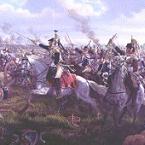larizona55
Posts: 83
Joined: 4/20/2005
Status: offline

|
Just to muddy the waters, there is an article in the April 04 Journal of Military History by James Arnold.
His basic premise is that english speakers conception of French tactics have been influenced too much by Oman, who seemed to think that the French foought mostly in column. But in reality, the French used an entire "toolbox" of formations, based on the tactical situation, and bounded only by occasional dictate, or after 1809 poor training.
A few quotes from the text of the article:
"One of the strengths of the Reglement of 1791 was its flexibility permitting a combat commander a variety of choices in executing a maneuver. Historian John Lynn studied the tactical formations used in 108 engagements fought by the Armee du Nord between April 1792 and July 1794. he found flfty-nve recorded instances of the French deploying into line and cited seven examples of the line in attack and thirty-five cases of column attacks. Lynn concluded that "commanders placed their soldiers ... in ways which exploited terrain and met the tactical challenge. Battalions stood in a full close order repertoire of line, column, and square or dispersed in open order."'^ This conclusion applies to French infantry throughout the Napoleonic Wars.
Consider the 9 june 1800 Battle of Montebello. General Francois AVatrin opens the nght by deploying two battalions of the 6th Legere into line and charging the Casteggio heights. General Claude Victor brings reinforcements. The commander of the 43rd Demi-Brigade places his two flank battalions in open order and keeps his center battalion in column. The 96th Demi-Brigade is the next unit onto the field. It charges Gasteggio in battalion column. Throughout the battle, the French infantry exhibits a well-considered variety of tactical formations, effortlessly deploying from one to another while under artillery Are.16"
Also a quote from the text damning Oman's assesment give some interesting thoughts on line attacks...
"Oman stated that the Emperor's "most celebrated battle strokes seem frequently to have been made by very gross and heavy masses."21 Sir Charles cited Marshal Nicolas Soult's assault on the Pratzen Heights during the battle of Austerlitz in 1805 as an example.22 However, he is wrong.
The tactical details of the attack by Soult's 1st Division are clearly described by a French participant, General Paul Thiebault.23 Nearing the village of Pratzen, the 1st Battalion of the 14th deploys into line and is rebuffed in its attack upon the village. Thiebault leads a counterattack with the regiment's 2nd Battalion which "deployed as it ran."24 Gaining the heights Thiebault is confronted by a heavy Russian counterattack. To respond to this challenge, he orders the 36th to deploy with all speed. The decisive engagement of the battle ensues.
Lest there be any doubt about Soult's maneuvers, the deployment into line was observed and recorded by Karl Stutterheim, an Austrian eyewitness.25 Thus, contrary to Oman, the spearhead of Napoleon's "battle stroke," at the Emperor's most celebrated battle, nghts the decisive action in line.
Another French tactic used by the Grande Armee was to dissolve entire battalions into skirmish order. Oman is also mistaken about this point. Hc wrote: "I do not remember any case in the Peninsular battles where whole battalions were broken up into skirmishers. . . . Nor do I think that it occurred often, if ever, in any of the imperial battles."26
In the Peninsula at the Battle of Busaco, a French participant recounted how an entire brigade in Ney's Corps dispersed into skirmish order as it fought along the ridge slopes.27 Following the Battle of Salamanca, the French under General Joseph Souham engaged in heavy skirmishing with Wellington. At the forefront of the action was Colonel Bechaud, who provided a detailed account: "the two left flank companies fired upon the advancing enemy columns . . . the remainder of the U 5th dispersed into skirmish order . . . after twenty nve minutes . . . the enemy turned our left . . . and our cloud of skirmishers were forced to retreat."28 The 15th then reformed into a two-deep line and opened Are. Later in the day the eight companies of the 15th and 66th again broke into skirmish order.
Similarly, many French units fought in imperial battles while in skirmish order. In 1806 the report of the 16th Legere at Jena described how "the third battalion advanced into the woods in skirmish order. "29 Throughout the Ratisbon phase of the 1809 campaign, the French made extensive use of massed skirmisher tactics.30 Even in 1813 the French were capable of deploying entire units in skirmish order. The Russian general Langeron recounted how the French left at Lutzen launched its counterattack in skirmish order.31 During the retreat from Leipzig, when the French encountered the Austro-Bavarian army at Hanau, Macdonald placed two battalions of Old Guard Chasseurs in skirmish order, supported them with Old Guard Grenadiers, and attacked.32
In and of themselves these examples arc not of surpassing historical importance. Skirmish order was merely one available formation that French commanders could select from the tactical tool box. However, the fact that the French were routinely capable of deploying entire units into skirmish order challenges Oman's expertise in French small-unit tactics."
This should keep things nice and muddy....
Larry
|
 Printable Version
Printable Version










 New Messages
New Messages No New Messages
No New Messages Hot Topic w/ New Messages
Hot Topic w/ New Messages Hot Topic w/o New Messages
Hot Topic w/o New Messages Locked w/ New Messages
Locked w/ New Messages Locked w/o New Messages
Locked w/o New Messages Post New Thread
Post New Thread